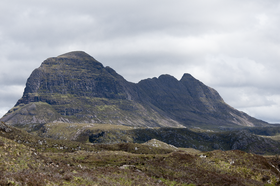Suilven
| Suilven | |
|---|---|
| Sula Bheinn | |

Suilven
|
|
| Highest point | |
| Elevation | 731 m (2,398 ft) |
| Prominence | c. 496 m |
| Listing | Graham, Marilyn |
| Coordinates | 58°06′54″N 5°08′13″W / 58.115°N 5.13707°WCoordinates: 58°06′54″N 5°08′13″W / 58.115°N 5.13707°W |
| Naming | |
| Translation | The pillar (Old Norse + Scottish Gaelic) |
| Pronunciation | Scottish Gaelic: [ˈsulə vjeɲ] |
| Geography | |
|
|
|
| OS grid | NC153183 |
| Topo map | OS Landranger 15 |
Suilven (Scottish Gaelic: Sula Bheinn) is one of the most distinctive mountains in Scotland. Lying in a remote area in the west of Sutherland, it rises almost vertically from a wilderness landscape of moorland, bogs and lochans known as Inverpolly National Nature Reserve.
Suilven forms a steep-sided ridge some 2 km in length. The highest point, known as Caisteal Liath (the Grey Castle in Scottish Gaelic), lies at the northwest end of this ridge. There are two other summits: Meall Meadhonach (Middle Round Hill) at the central point of the ridge is 723 m high, whilst Meall Beag (Little Round Hill) lies at the southeastern end.
Geologically, Suilven is formed of Torridonian sandstone, sitting on a landscape of Lewisian Gneiss. The surrounding rocks were eroded during an episode of glaciation. Suilven was left poking above the level of the ice sheet, as a nunatak, with the flow of ice creating the distinctive narrow teardrop plan, while carving and scouring the vertical sides of the mountain.
From the coast to the west Suilven looks like a large grey pillar, hence the name which it was given by sea-borne Vikings. From the inland side the mountain has more of the appearance of a steeply-sided pyramid.
In 2005 Glencanisp estate, of which Suilven forms part and the neighbouring Drumrunie estate, were bought by the local community with the help of the John Muir Trust. The Assynt Foundation aims to create local employment and safeguard the natural and cultural heritage for the benefit of the community and future generations, and for the enjoyment of the wider public.
...
Wikipedia

